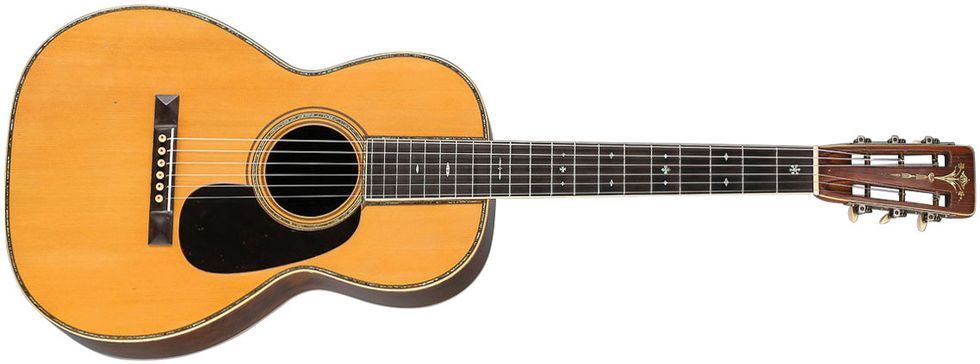Whether doing an online search or taking a stroll through your local guitar shop, it seems there are a lot of used guitars available these days. Some are barely more than a decade old, and some are vintage, but the sheer number compared to what you could find 10 years ago prompts the obvious question: Where do all these guitars come from? It’s a legitimate question, and the answer has more to do with changing demographics than it does with guitars and music. Unlike the early 1980s, when there were lots of used guitars for sale simply because the guitar wasn’t as popular as it had been in the decades preceding, this new influx is happening while guitars are generally selling quite well.
The most obvious reason so many guitars are coming back on the market is that baby boomers aren’t buying guitars (and lots of other things) the way they have in the past. While “second-phase boomers” (those born between 1955 and 1964) are often still in the hunt, “first-phase boomers” born between 1944 and 1954 are definitely slowing down their acquisitions, even if they’re continuing to play.
Only a fraction of baby boomer guitarists became serious guitar collectors, but it’s important to remember that this group, as a whole, is made up of avid collectors of lots of things. It’s not that baby boomers invented collecting. Guns, coins, and art have inspired collectors for decades. But boomers—bless their only-more-beats-more hearts—pushed collecting to a whole new level. Being cultural symbols made by iconic brands in many different shapes and styles, guitars seem almost designed for the collectors’ mentality. If you love your late-’50s sunburst maple-neck Strat, a ’60s version in Lake Placid blue with a rosewood fretboard will feel similar and different at the same time. Then, of course, there are many other Fenders, and many other versions of the Stratocaster.
In the acoustic realm, C. F. Martin tickled fans of Eric Clapton’s acoustic comeback with a 000-42EC model in 1995, and then repeated that success with several other Clapton models in the years that followed. Despite the fact they all were size-000, 14-fret Martins, some folks bought every single version.
The ideal collectability of stamps and coins usually doesn’t stress even a small closet as the collection expands, but the same can’t be said for guitars. A dozen guitars doesn’t strain the average home, but when the number climbs much higher than that, storage becomes an issue—especially if the collector tries to maintain proper temperature and humidity for wooden instruments. For empty nesters, this usually isn’t a problem thanks to Junior’s now-unused bedroom closet. When boomers face downsizing their homes after retirement, however, some things have to go. And guitars, especially the ones not being played, are frequently in the crosshairs.
This is where baby boomers’ downsizing dilemma gets interesting. While serious collectors probably always realized their instruments would be sold at some point, many amateur collectors did not. For those who only acquired a few instruments, passing them down to their kids or grandkids was often the stated goal. Nostalgia can wear thin outside a picture frame, however, and the baby boomers’ musical heroes are frequently only a historical footnote for the generations that followed. A talented granddaughter may be a far more avid guitar player than her grandpa, but that pearl-bordered antique Martin—similar to the one Joan Baez played—is probably of little interest to a young singer-songwriter whose inspiration is Taylor Swift.
More critical is how the generations that followed the boomers see the guitar itself, and how it fits into their lives. Those vintage Strats may be what dad always wanted, and their rise in value has been deeply satisfying. But to Junior, despite his impressive chops on electric guitar, a vintage Strat may be little more than a white elephant. Junior can’t sell the vintage Fender without pissing off Dad, he can’t modify it without whacking its originality (and thus its value), and who wants to haul around a guitar worth over ten grand anyway? If selling the guitars Dad bestows isn’t an option, Junior might have been happier if his father had collected Danelectros so he could loan them out to friends without worrying about them.
Of course, the effects of post-recession 21st-century realities aren’t limited to guitar collections. Similar changes in taste have had a far more dispiriting effect on baby boomers who collected pottery, for example, and heaven help the collector who focused on 4-string banjos. Guitars are still being played all over the world. And all those used and vintage instruments coming back on the market may be grateful for a chance to see more of that world—especially after years of being confined in baby boomers’ closets.













![Rig Rundown: Russian Circles’ Mike Sullivan [2025]](https://www.premierguitar.com/media-library/youtube.jpg?id=62303631&width=1245&height=700&quality=70&coordinates=0%2C0%2C0%2C0)





